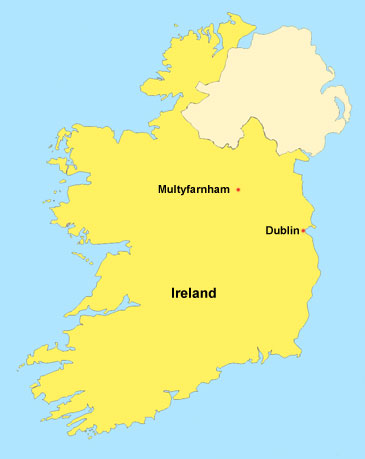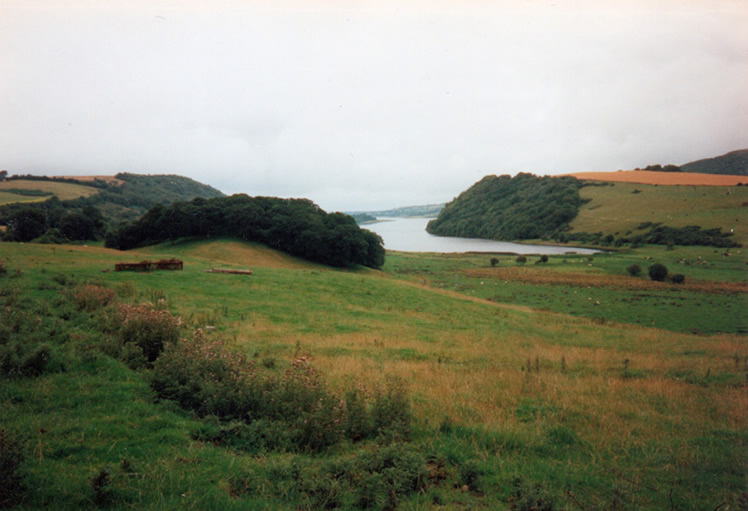 Chris Korte's New Zealand Genealogy Project
Chris Korte's New Zealand Genealogy Project
Multyfarnham, Westmeath, Ireland
About page
This page has information about Multyfarnham in Ireland. Multyfarnham was the birth place of James George Heavey in 1866. He subsequently migrated to New Zealand with his family, in about 1879.
If you can provide additional information, or corrections, please contact (see Info menu).
Multyfarnham
Multyfarnham (Muilte Farannáin in Irish) is a moderate sized rural village located in County Westmeath, Ireland. In 2006 the population of Multyfarnham was 193. Multyfarnham is the site of an acient Franciscan friary.
The village is beside the River Gaine, about 1.5 km from where it flows into Lough Derravaragh. Lough Derravaragh, a lake with an area of over 2700 acres (1080 hectares), is an attraction for fishing, boating and swimming. Multyfarnham is located approximately 10 km to the north of Mullingar, the nearest town. It is a village of considerable rural character situated in a high quality landscape dominated by hills and lakes.

Franciscan Abbey
The Franciscan friary of Multyfarnham was founded in 1236 and became a renowned centre of learning. In the 15th century the friars rebuilt their church and its tower. Between 1590 and 1617, the Abbey was raided six times and twice burnt by the English. When Mons. Massari visited in 1646, there were 30 friars. In 1766 there were seven friars but five were very old. The church was unroofed from 1651 to 1827. A new friary was built in 1839.
Parts of a 15th century church survive in the present friary church (photo below), including the nave, south transept and tower, as well as the south window (though not its glass). Nothing remains of the chancel or of the original domestic buildings. The church was given its present form in 1827 when the Franciscans returned to their old monastery. The church was refurbished in 1976.

Multyfarnham Friary Church
Photograph by John Armagh 2008
A seraphic college was opened in 1899, there being only four pupils the first year. This became an agricultural college in 1956, and continued as such until 2003. Today the Friary is made up of a church, house, old agricultural college and extensive grounds.
Two features in particular make Multyfarnham Friary a very special place. The first is the beautiful, secluded garden, shaded by old trees in which there are outdoor Stations of the Cross. The second is the brilliant modern stained glass by Richard King. Its central figures are four swans, with silver chains around their necks. This commemorates the ancient legend of the Children of Lir.
The children were transformed to swans by their wicked stepmother and endured the enchantment for a period of nine hundred years, of which they spent the first three hundred on Lough Derravaragh, just two miles from the friary. The shape of the lake is very much the same as the shape of a swan in flight. The story ends when they were rescued and cared for by St. Mochaomhog. They became human once more, but in the form of old and decrepit people and they died soon afterwards – but not before they had been baptised by him so that they could be buried as Christians.
19th Century Multyfarnham
I have been unable to source much information on Multyfarnham during the 19th Century. The following is based on more general information for the region and country.
Poverty was a feature of County Westmeath during the 19th century. A lack of sufficient employment and the ravages of the Great Famine (1846-1849) led to an upsurge of emigration to Britain, America, Australia, Canada and Argentina. Changing agricultural practices, recession and unjust land laws led to many evictions and much violence in parts of the rural hinterland during the 1860s and 1870s.
Most people in County Westmeath were Catholic (90%) and illiterate. At the 1841 census, 27% of people in Westmeath were literate. Most Irish landlords were Protestants. The Irish peasants themselves, who were both Protestant and Catholic, ate potatoes almost exclusively.
The white "Irish potato" originated in the Andean Mountains and was taken to Europe by the Spanish in the second half of the 16th century. By 1800, the potato had taken root and ninety percent of the Irish population was dependent on the potato as their primary means of caloric intake and as an export.
In September of 1845, a fungus called Phytophthora infestans was infecting Ireland's potato crops, devastating the potato population. About half the Irish potato crop failed in 1845. This event is what began The Great Famine in Ireland. The next year, 1846, the crop was destroyed again. By 1847 (Black '47) the impact of the famine spelled doom for Ireland. A large proportion of the population died from disease or starvation, while a great number of the people fled the country, largely occurring in a five year period between 1846 to 1851.
It has been estimated that between 1841 and 1851 (census years) about 23,000 people from Westmeath (15%) either died or emigrated due to the famine. Westmeath had 148,000 people in 1841. In the following decade from 1851 to 1861 a further 16% of the 1851 population are estimated to have emigrated.
Nineteenth century Mullingar (the nearest town to Multyfarnham) was an important military centre and British army regiments were stationed in the town. Many of the soldiers married local women and settled in town. The army also supplied a source of employment for locals and men served all over the British Empire.
A transport revolution occurred with the opening of railways. Multyfarnham railway station opened on 8 November 1855.

Lough Derravaragh
Photo by S. Hovey 2008
Last Heavey Resident
Con Maxwell, a previous resident of Multyfarnham, has provided information on the last Heavey resident of Multyfarnham. When Con grew up in the 1960's there was a derelict cottage outside the village previously occupied by the Heavey family. The last occupant was Matt Heavey, probably a stonemason, who died in the late 1950's. There were a few acres of land with the cottage. Con believed Mat was single and had no children. After Matt's death the cottage was sold to a family called Fagan who lived about 200 metres away. They used the cottage to house a few pigs. The cottage had 2 rooms, a slate roof and a horseshoe over the door. The horseshoe was used in this manner to bring good luck. About 2000 the cottage was demolished and new house was built on the site - the townland is called Fulmort (or Fulmorth).
Page last updated on 25 July 2018.







